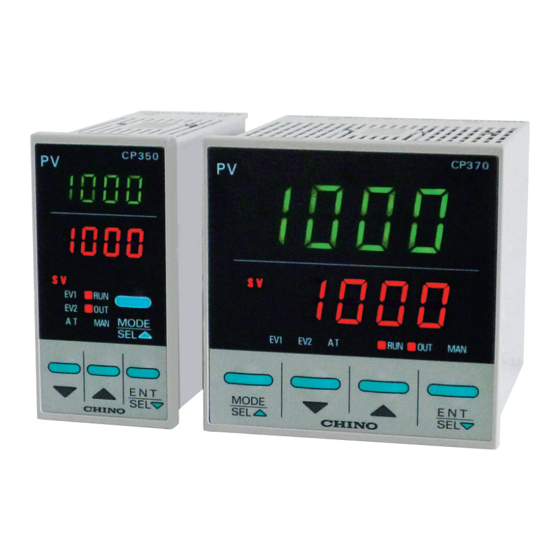
Summarization of Contents
For Safe Use of Product
Strictly observe the instruction manual
Emphasizes reading and following manual for safe product use.
Disclaimer of liability
CHINO not liable for damages from improper use or manual errors.
Install safety instruments on the system side
Recommends safety instruments for critical facilities and fail-safe design.
Need for basic knowledge on the controller
Product requires users to have adequate knowledge of controllers and equipment.
Confirm the power supply voltage and wiring
Check power supply voltage, wiring, and grounding before operating the product.
Protection of terminal section
Recommend safety measures for terminal section to prevent electric shock.
Actions in the case of suspicion
Instructs to turn off power immediately for smell, noise, smoke, or abnormal temp.
Prohibit repairing and modifying
Only authorized engineers should perform repairs or modifications on the product.
Installation and Mounting
External Dimensions
Provides detailed external dimensions for CP350 and CP370 models.
Panel Cutout Size
Specifies panel cutout dimensions for single unit and closed installations.
Installation Conditions
Details environmental and atmospheric conditions required for proper installation.
Panel Mounting Method
Explains the step-by-step procedure for mounting the product into a panel.
Wiring
Terminal Board Diagram
Shows the terminal board diagrams for CP350 and CP370 models.
Basic Wiring
Covers confirmations before wiring and basic wiring principles.
Terminal Function Diagram
Details the function of each terminal across different rows (A, B, C).
Precautions for Wiring
Lists important precautions to follow during wiring procedures.
Procedure of Initial Settings
For Constant-value Control
Outlines the minimum required initial settings for constant-value control mode.
For Program Control
Outlines the minimum required initial settings for program control mode.
Front Panel
Display
Describes the function of each display element (LEDs) on the front panel.
Key Operation Section
Explains the function of each key on the front panel for operation.
Screen Configuration and Basics of Setting
Display Configuration
Illustrates screen transitions between operation and setting modes.
Basics of Setting
Explains how to navigate and perform settings using the front panel keys.
Screen Character Font
Displays the character font used for screen text, showing characters and numbers.
Setting Screen
mode 0
Details settings for mode 0, used for main parameters during execution.
mode 1
Details settings for mode 1, dedicated for constant-value control parameters.
mode 2
Details settings for mode 2, dedicated for program control parameters.
Program Pattern Setting
Explains how to set up program patterns for control, including steps and timing.
mode 3
Details settings for mode 3, used for setting eight types of parameter groups.
mode 4
Details settings for mode 4, used for setting event parameters.
mode 5
Details settings for mode 5, used for setting measurement input parameters.
mode 6
Details settings for mode 6, used for control algorithm and output 1.
mode 7
Details settings for mode 7, used for control output 2 parameters.
mode A
Details settings for mode A, used for communications parameters.
mode B
Details settings for mode B, used for transmission signal output parameters.
mode C
Details settings for mode C, used for external input parameters.
mode T
Details settings for mode T, used for setting the system configuration.
Operation
Trial Operation
Guides through the step-by-step process of trial operation before real use.
Various Operations
Explains different operational statuses and modes like RUN, READY, and Program control.
Precautions for Operation
Provides critical precautions for operating the device safely and correctly.
Detailed Functions Description
Event
Describes various event types, including alarm and status events with diagrams.
External input
Explains how external inputs affect the device's operation and functions.
PID
Explains the basic operation of PID control and its components (P, I, D).
Two Outputs
Details the functionality and configuration of two-output control systems.
Checking and Maintenance
Checking
Outlines procedures for checking the product before operation and periodic checks.
Life Component
Lists components with limited lifespan and their estimated operational life.
Disposal
Provides guidelines for the proper disposal of the product according to regulations.






Need help?
Do you have a question about the CP370 Series and is the answer not in the manual?
Questions and answers